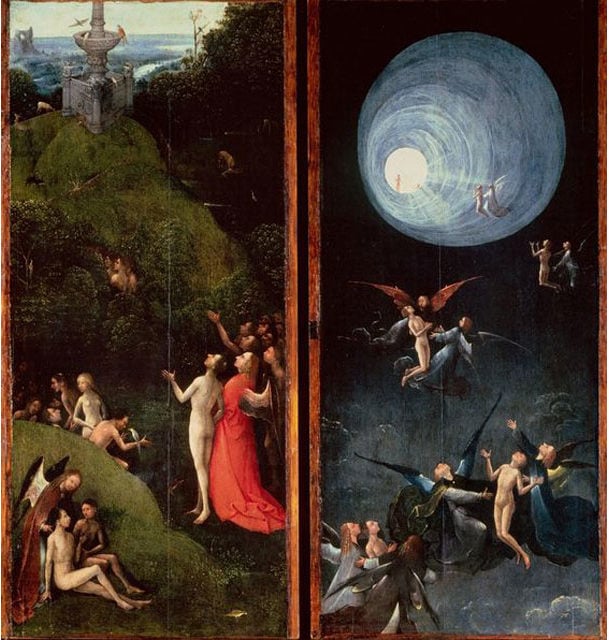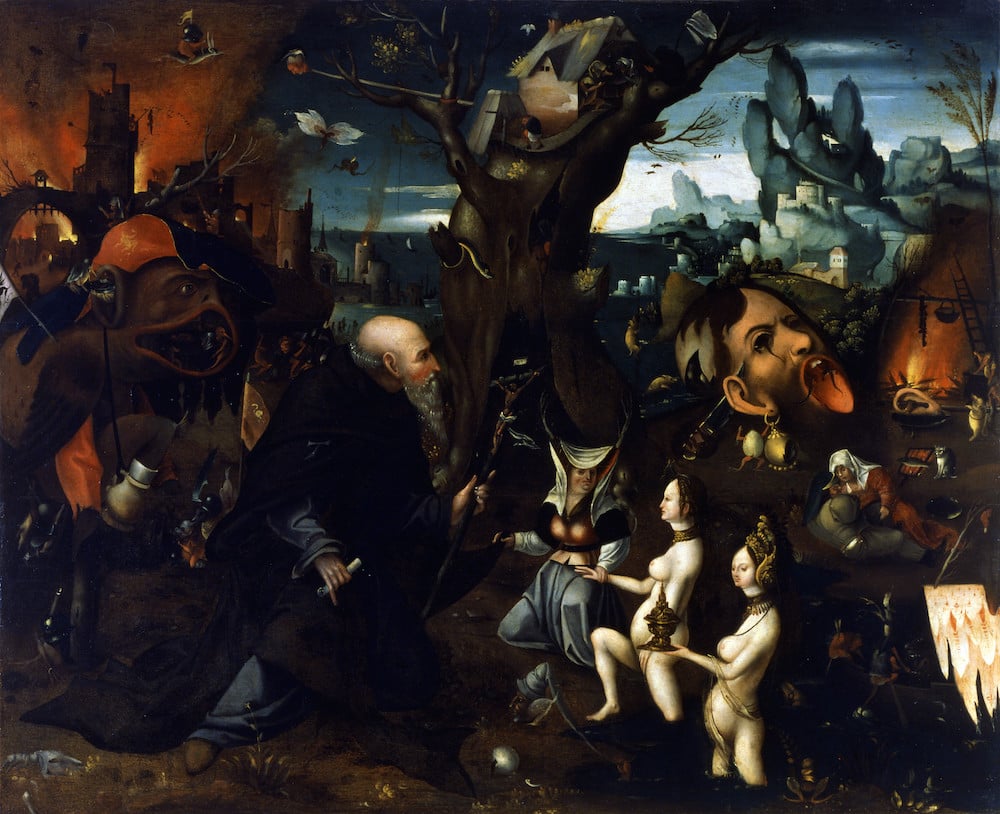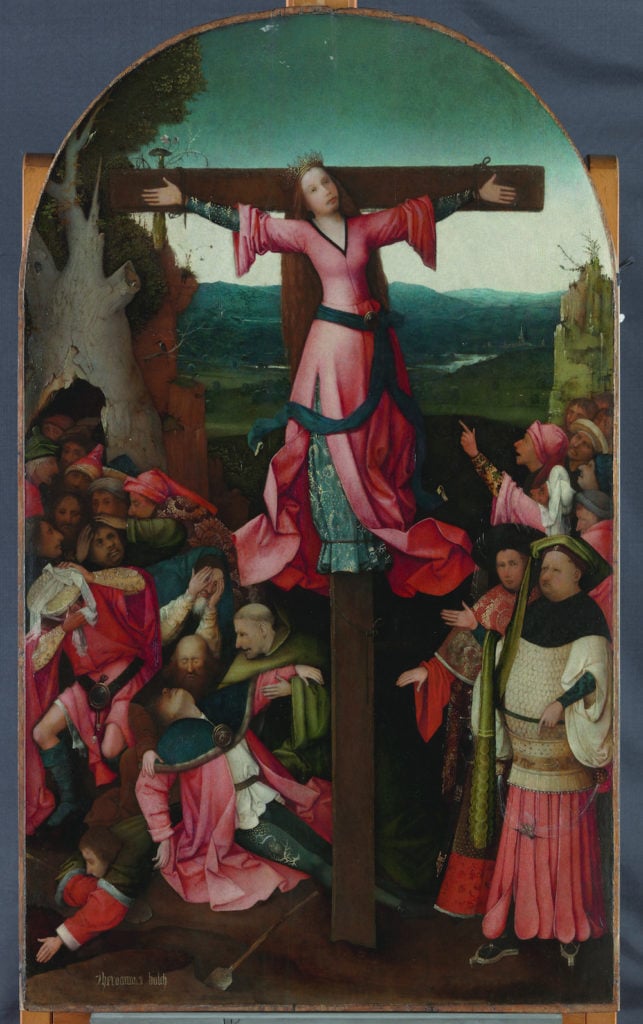Reviews
A Bearded Lady Is the Star of the Hieronymus Bosch Exhibition in Venice
The show features newly restored paintings from the city's collection.

The show features newly restored paintings from the city's collection.

Sarah Hyde

A beautiful girl with long, straight, blonde hair is pulling her boyfriend along at speed as we pass in a dark alleyway, somewhere near Accademia, in Venice. She’s wearing an immaculate little black dress matched with a simple velvet mask and red lipstick. For tonight, at least, she is absolutely gorgeous and crackling with energy. With a flick of her hair and a careless laugh she disappears, lost into the crowd, leaving me with only the memory of her features. In that moment the mystery of the Venetian Carnival transcended time, and reached out to me.
Perhaps to counter potential temptations of the flesh, the “Bosch and Venice” exhibition opened on February 18, a powerful visual reminder of exactly where sin can get you—or, if you are inclined to sin anyway, a lesson in how to do it really well.
Bosch takes you on a medieval journey from virtue through temptation and into the mouth of hell. As you enter the Doge’s Palace and climb the magnificent yellow staircase, it is easy to imagine yourself as a visiting ambassador, arriving by sea, and climbing these humbling stairs in the hope of getting a warm reception.
In this impressive context, the exhibition’s focus is on small, jewel-like paintings conserved in the Gallerie dell’Accademia—two triptychs and four panels—that have been restored in a major effort financed by the Bosch Research and Conservation Project (BRCP) and the Getty Foundation, Los Angeles: The martyrdom of Saint Uncumber (Wilgefortis, Liberata), three hermit saints, and Paradise and Hell (Visions of the Afterworld).
Lit from above, the size of the grand location appears reduced. Looking at the artworks feels like gazing down into a miniature theater, and you wonder if this omnipotent point of view is intentional.
Given the nightmarish quality of Bosch’s work, this is no bad thing. A Lilliputian version of hell is one thing: manageable. At the end of the exhibition, though, there’s a virtual reality rendering of Heaven and Hell that is quite alarming, although the children at the exhibition seemed to be taking it in their stride.

Anonimo seguace di Hieronymus Bosch, Tentazioni di sant’Antonio, metà del xvi secolo olio su tavola Venezia, Museo Correr, legato Teodoro Correr 1830, inv. Cl. i n. 160, 2017. ©Archivio fotografico – Fondazione Musei Civici di Venezia
Bosch is venerated today for being extraordinary, curious, and deeply perverse, as he was when his works were new over five hundred years ago. In his day, he was considered to be a moralist. Today, however, the works seem to ask many more questions than they can answer. No artist represents waking horror quite like Bosch, although Francis Bacon may have surpassed him with his focused figurative work. Despite advances in technology which have enabled human beings to go much further in articulating their deepest fears, Bosch is still the master. The thought of what he could have achieved with modern technology is truly mind-bending.
Bosch was not an outsider. He came from a family of painters and these panels represent traditional biblical scenes. Like other artists of his age, Bosch represented his patrons on the panels, and in this elegant Italian context, their faces seem very Dutch and lumpen. The central panel contains the main image, and the narrative moves from left to the right. It is easy to spot St Jerome and St Anthony and we already know the story, but any similarity with other painters ends there, and Bosch’s incredible imagination takes flight, leaving behind something that, five hundred years later, is still astonishing
All his works are littered with iconography and visual metaphor, from birds to much less familiar creatures, strange new monstrous species, figments of the artist’s imagination, visionary landscapes, curious German architecture, torture with agony on the scale of the Spanish inquisition, plenty of apocalyptic fire, curious submarines, and the mouth of hell itself—images that swirl through our minds and into our subconscious like an uncontrollable waking nightmare.

Hieronymus Bosch, Trittico di Santa liberata o Wilgerfortis (1495-1505 circa). Courtesy ©Archivio fotografico Gallerie dell’Accademia.
The mystery invested in these works, an allusion to layers of knowledge, is what makes them truly exceptional and open to a mystical interpretation. It was this quality that brought them to Venice, a city already full of wonderful art in the 15th century. The panels were purchased on behalf of Cardinal Domenico Grimani, a discerning collector with a developed interest in the esoteric. He also collected Hebrew manuscripts, classical statues, and fabulous illuminated manuscripts, many of which are on display in the exhibition, providing a context for the paintings, in addition to many other representations of hell by artists influenced by Bosch.
Cardinal Domenico Grimani was particularly interested in buying artworks in the Netherlands and it was his agent who visited Bosch’s studio soon after the artist’s death and bought three triptychs, two of which remain. It is hard to imagine the conversation between the Cardinal and his agent when the panel featuring St Uncumber was delivered.
Also known as Wilgefortis, St Uncumber, a female saint, is not an easy subject. She is also represented in Westminister Abbey, but rarely discussed these days. Remarkably, Uncumber was beatified for being bearded. The cult of Uncumber or Wigerfortis was strong in the 14th century and she became the Patron Saint of women who wanted to be free of their husbands.
According to legend, as a young noblewoman, she was affianced by her father to an angry, unpleasant king. Terrified of this fate, she took a vow of celibacy and prayed to be made undesirable. Her prayers were answered and it is said that she sprouted a fine beard! Horrified, her father had her crucified. In Bosch’s panel she appears as a female Jesus, dignified and bearded on the cross surrounded by chaos, destruction and drama on an apocalyptic scale. Perhaps now is the time for Wilgerfortis to be reconsidered.
“Bosch and Venice” is on view at The Grand Ducal Apartments, Venice, until June 4, 2017.